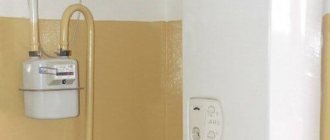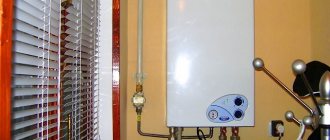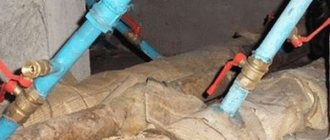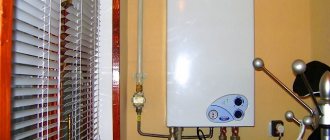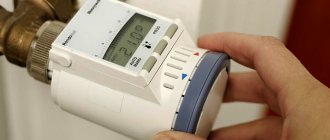According to the assurances of some high-ranking executives, “Russians’ incomes are growing at an unprecedented rate.” Who knows, maybe in average statistical terms such growth is noticeable to some, but the majority of such statements remain somewhat bewildered. But what is much more obvious to the wallet is the regular, recently even twice a year, increase in utility tariffs. And this circumstance encourages even previously somewhat negligent apartment owners to look for ways to maximize savings on consumed resources. And one of the most “weighty” items in the overall estimate of utility bills was and remains home heating.
Common house heating meter - does it help you save?
If electric meters have long become “familiar” to everyone, gas meters and water meters have not raised any special questions, then there is no such clarity yet with meters for metering consumed thermal energy. Meanwhile, such accounting is also becoming mandatory. According to Federal Law No. 261-FZ of November 23, 2009, as amended on August 3, 2018, “On energy saving and increasing energy efficiency, and on introducing amendments to certain legislative acts of the Russian Federation,” which came into force on August 10, 2018, energy metering devices must be installed in every residential apartment building.
That’s why many apartment owners have a logical question: does a common building meter for heating help save money, or will the money on installing it be wasted?
Let's try to figure it out...
Why do you need a meter?
It is immediately necessary to clarify that information about devices that provide accounting for energy consumption is collected in Article No. 13 of the above-mentioned Federal Law. This section of the document also specifies some exceptions to the general rules. That is, those multi-apartment buildings are listed in which the installation of meters is not mandatory.
In principle, little depends on the wishes of the residents of an apartment building - federal law obliges them to have a common building meter.
So, these exceptions include:
- Residential buildings that are in disrepair and are subject to resettlement, or in which major repairs are planned in the near future.
- Small houses in which the joint payment from all apartments for heating for a six-month period is less than the cost of a heat meter.
The concerns of residents of houses in which it will be necessary to install communal meters are understandable. This is largely due to the fact that the purchase and installation of metering devices must be carried out at their expense. And the total costs can be quite impressive.
Now it’s worth defining the functions of these devices so that it becomes more clear why the requirements for their installation are put forward.
You should not think that thanks to the installation of meters for consumed thermal energy, savings in material terms will be immediately felt. No, such devices are intended solely for metering heat consumption. And real savings can only be achieved through high-quality thermal insulation - cladding the walls of the house with insulating materials, installing high-quality window systems with double-glazed windows. Much also depends on compliance with the general “heat saving discipline” by all owners of apartments in the entrance. This means that the front door is well fitted and kept closed at all times, there are no drafts on the landings from broken or poorly fitted windows, etc. After all, the entrance is also considered a common house sealed room, and everyone also has to pay for its heating.
In this way, through combined efforts, it is possible to minimize heat losses, and therefore significantly reduce heating bills. Otherwise, if even individual residents do not fit into this saving regime and ignore the comments of their neighbors, the cost of heating may increase significantly, since the total consumption of heat consumed will be reflected on the common building meter.
If residents indifferently pass by such “beauty” in their entrance, then they should not expect a reduction in their bills after installing a building-wide heat meter. Rather, it will turn out the other way around...
So why was this law developed, and who benefits from installing communal meters?
- An obvious benefit for residents of houses who have invested in home improvement. Using a heat meter, calculations will be made objectively, that is, not according to the average tariffs established in a particular region, but according to specific consumption indicators. Indeed, it is unfair if residents who take good care of their home and those who are apathetic about preserving heat pay the same rates for heating.
- Incentives for owners of apartments in multi-apartment buildings to take an active part in preserving heat in their hallways. When residents know that an open driveway door or broken window will affect their heating bills, doors are more likely to close carefully and window glass will be more intact. The economic argument is usually more effective, weeks of endless persuasion, scandals, swearing at meetings and calls for consciousness.
- However, one cannot help but pay attention to the fact that the developed law places guardianship of the house in this regard on its residents, removing it from public utilities. This is the most unpleasant thing for apartment owners, who already pay considerable sums for utilities, as well as for repairs to entrances and the house as a whole. Unfortunately, not all management companies honestly spend the material resources received for their intended purpose. Therefore, it often turns out that residents have to not only pay the monthly fee imposed on them by the management company, but also independently repair and insulate their entrances. This means that the only thing left to do is either put up with this state of affairs, or try to find a compromise that suits everyone with the employees of the management companies.
Some owners solve the issue differently - by installing autonomous gas heating in the apartment.
By the way, after the development of this law, many apartment owners, some of whom were simply tired of the constant “fight” with negligent neighbors, began to become much more active in switching their homes to autonomous heating. This does not completely relieve them of the obligation to pay for the heat consumed by the house. But, at least, maintaining the optimal thermal regime throughout their apartment is in their hands, and the overall savings in monetary terms often become very noticeable.
Advantages and pitfalls of an autonomous heating system for an apartment in a multi-storey building
It must be said that this approach also hides many nuances and considerable difficulties in implementation. In some cases, the applicant may be completely denied this. more about how to approach the implementation of the idea of autonomous heating in an apartment building in a special publication on our portal.
What problems may arise with the installation of a common house heat meter?
When implementing this law, residents of apartment buildings encounter many problematic situations, which include the following points:
- The first unpleasant news, which was already mentioned above, which will not please apartment owners, is that the purchase and the entire installation process of equipment is carried out at the expense of the residents of the house. Moreover, we are talking about quite impressive amounts - for example, compliance with the law sometimes costs an amount exceeding 150 thousand rubles. It won’t be difficult to recalculate expenses for each apartment.
- Metering devices require periodic maintenance, which consists of cleaning filters, carrying out verifications and other preventive actions. After the end of the manufacturer’s warranty, which is usually provided for a year, payment for further maintenance of the heat meter is entirely borne by the residents of the house. Moreover, even if the device is in good working order, the management company will most likely begin to collect a monthly fee to maintain it in good condition.
- The management company must pay the heat supplier monthly, according to the readings taken from the general building meter, otherwise the supplier may simply interrupt the heat supply to a particular house. However, debtors are always found among the tenants. Therefore, the accounting department of the management company most often solves this problem by distributing debts to “solvent” apartments. That is, conscientious residents, those who carefully pay for utilities, have to take the rap for those who do not want or cannot pay off their debts.
Quite often, there is such a “black sheep” (or even several) at the entrance, for which everyone else has to pay together.
- The law does not clearly regulate the situation related to possible malfunctions of the heat meter. Thus, there have already been cases where, when the meter failed, residents subsequently had to pay heating bills that were even several times higher than adequate amounts. And no one then wrote off these debts from the residents - it’s just that sometimes the management company, seemingly meeting the apartment owners halfway, provided a certain installment plan to pay off the debt in installments.
- But there is good news for residents of non-privatized apartments. They are not required to participate in the payment for the purchase and installation of the metering device. According to the law, their costs must be borne by the owner of the building - the municipal government or one or another organization, if the house is departmental.
Calculations of payments for intra-apartment and communal energy consumption
Previously, payment for heating attics and entrances was included in the heating bill for each apartment, and was tied to a certain tariff. Control over the condition of common property was entrusted to the management company, which received a fixed fee from residents for this.
The heating bill will also include the amount for heating common areas of the house - entrances, attics, basements.
Today, in accordance with the Decree of the Government of the Russian Federation dated 05/06/11 No. 354, clause 40 “On the provision of utility services to owners and users of premises in apartment buildings and residential buildings,” payment for all utilities, including heating, is divided into two points:
- Payment for heating a residential premises, that is, an apartment.
- Payment for heating non-residential common premises.
Accordingly, in the payment receipts, instead of one line, a line appeared - heating for single use (common house needs).
That is why apartment owners began to worry about the question of how to calculate the cost of heating an apartment and common areas of the house when installing a common building meter.
The procedure for calculating heating costs will directly depend on the presence or absence of individual heat meters in the apartment. There are three options:
- The house has a communal energy meter; there are no individual appliances in the apartments.
- The house has a communal meter installed, partly or even all apartments are equipped with individual heat consumption metering devices.
- There is no communal meter installed in the house (which, as we remember, is already contrary to the current Law).
The first option is that individual heat meters are not installed in the apartments.
This situation is typical for most apartments. Only a few homeowners, in order to independently control the consumption of thermal energy, have installed individual meters for metering the consumed thermal energy.
In some cases, circumstances allow you to independently control the amounts to pay for heating. Often everything turns out very confusing, and the apartment owner simply does not have the necessary information for such calculations.
It should be noted that sometimes their installation is unprofitable, and in some cases it is completely impossible. For example, if the house has an old-style heating circuit installed, that is, it consists of vertical risers that “pierce” the apartments from the first to the top floor. In such systems, individual metering devices have to be installed on each radiator. So, most likely, the costs of purchasing them and installing them will not be justified, or this will not happen very soon.
So, if there are no heating meters in apartments, but a common house heat meter is already installed in the house, then calculations are made for two items - apartment heating and single-room heating. As an example, we can consider the following option with conventionally taken area values and heating prices:
- The readings of the general house meter over the past month amounted to 300 gigacalories. The exact readings of the device must be indicated on the receipt or you can find them out from the management company (MC).
- Next, you will need to find out the total area of the house, which includes all, without exception, heated premises (apartments, entrance areas, attics, basements, common technical rooms, etc.) For example, it is 7500 m². The exact data is also indicated on the receipt, or you can also find it in the Criminal Code.
- The area of the specific apartment for which the calculation is being carried out is 80 m² - this parameter is indicated in the technical passport for the apartment.
- And finally, the established tariff for heating - let it be 1350 rubles per 1 Gkl (gigacalorie). The tariff for this service is set by the executive authorities of the constituent entities of the Russian Federation. It’s easy to find on the pages of local Internet resources.
So, having all the above data, the amount of payment for heating the apartment for the past month is calculated using the following formula:
M = Q × ( Sк / Stotal) × T
Where:
M — accrued amount to be paid for consumed heat;
Q - taken readings of the common house meter for the billing period;
Sк is the area of the apartment for which the calculation is carried out;
Stotal - the total area of all heated premises of an apartment building;
T is the regional tariff per unit of consumed heat.
In our example it turns out:
M = 300 × (80 / 7500) × 1350 = 4320 rubles.
To simplify the task for the reader, below is a calculator, which already contains the above-mentioned formula:
Calculator for calculating the amount of payment for heating in the presence of a common house meter
Go to calculations
The second option is that an individual heat meter is installed in the apartment.
If the apartment has a heat meter installed, payment is made as follows:
- Heating of the apartment is paid according to the readings of the individual meter - the difference found during the calculated period is multiplied by the current tariff.
- The amount for heating common premises is calculated based on the difference between the readings of individual meters in apartments and the common building meter. In this case, the area of the apartment is again taken into account, and for this a formula similar to that presented above is used. But, without having information about individual heat consumption in other apartments in the house, it will not be possible to calculate the amount for your own. So you have to trust the accounts calculated by the employees of the management company.
The third option – there are no heat meters
According to the law, this should practically never happen anymore. However, this kind of thing still happens. So, if neither the house nor the apartments have heat metering devices installed, then payment is made according to the tariffs established by regional authorities for 1 m² of apartment, plus for heating common premises.
Heating tariffs may vary in different regions of the country. In addition, they can be installed only for the heating season or distributed evenly throughout the entire calendar year. Both cases do not contradict current instructions. Year-round payment, however, allows you to reduce the “financial burden” during the heating season. But on the other hand, paying for heating in the summer months seems extremely opaque and is usually much more difficult to accept psychologically.
At the end of the heating season, in any case, a recalculation is carried out based on the actual temperature conditions of the heating system over the past months. And here it depends. Either residents are refunded the overpaid funds (more precisely, they are offset against future payments), or an invoice is issued for additional payment.
Alternative ways to heat an apartment
If the proposed ways to save on heating fees do not fully satisfy you, and your home is fundamentally suitable for individual heating, then you can resort to radical measures - abandon the central heating supply. But we warn you, obtaining permission to refuse central heating and install individual heating is quite difficult.
If you have nevertheless made such a decision, then it’s time to think about how to heat the apartment yourself. The modern market offers many different alternative heating methods. All of them can be divided into three large groups:
- electric heaters (from the cheapest oil radiators to film and quartz monolithic devices);
- heated floors (water, cable, infrared);
- heating boilers (gas, electric, solid fuel, combined, etc.).
The choice of a specific method for arranging autonomous heating depends on many factors, so it is impossible to give universal advice on this matter. It is better to trust energy professionals in these matters. We will limit ourselves here to the most general comments.
The advantage of heaters is the possibility of installing them in a room with ready renovation, that is, this method of alternative heating does not have to be taken into account at the project stage. There are quite a few disadvantages, each type of heater has its own.
Warm floors create the necessary microclimate in the apartment, consume little energy, and the amount of heat can be adjusted independently. But installing them is not so easy, because they are mounted into the floor screed, and not every floor covering is suitable in this case.
Alternative heating in an apartment based on gas or electric boilers is a profitable investment of money, but not time. It will be necessary to coordinate many issues with a large number of organizations, because this option for heating an apartment is a rather complex structure with a system of pipes and radiators filled with coolant.
According to experts, autonomous individual heating allows you not only to save on payments, but to achieve independence from resource supply organizations with their unpredictability and unreliability. Therefore, one of the options for heating a house instead of a central line is to equip house boiler rooms. Gas boiler rooms can be installed both on the roof of an apartment building, by installing a block structure, and in separate rooms or buildings. The new systems are equipped with threat and emergency alarms. A variety of sensors for gas boilers monitor many indicators. In the event of a breakdown, the backup boiler and additional pumps are activated. These solutions require additional investments from the general fund created by residents and obtaining all necessary approvals and permits from authorized authorities.
Gas heating systems release polluting decay products into the environment. Therefore, when installing boiler rooms, it is necessary to provide for the installation of filtration systems. Cleaning devices must perform their functions sufficiently to comply with SNiP standards. But this additionally increases the cost of purchasing equipment.
Is it possible to save money on heating at all?
From the above information we can conclude that a common house meter does not provide obvious benefits for residents. However, there are ways that will help you save money - these are individual heat meters installed in conjunction with thermostatic control devices for heating radiators.
Having such a device, you can independently control and regulate the heat supplied to the premises. In addition, if metering and temperature control devices are installed in all apartments of the house, this will allow their owners to be less dependent on each other.
Thermostatic regulator on the heating radiator - the room is maintained at the set temperature
- An individual metering device is mounted at the entrance of the heating pipes to the apartment. The meter must be sealed by representatives of the organization controlling the heat supply, otherwise its readings will be considered invalid.
- Thermostatic regulators are installed at the heating radiator inputs. A simplified option is chokes (regular or specially designed valves). thermostats. Of course, they are more expensive, but they make it easier to accurately regulate the temperature of each radiator individually. Thus, you can achieve a comfortable temperature in the rooms and not suffer from the heat by opening the windows when it’s +10÷15 degrees outside, and utilities are heated as if at -20˚C.
The best option is digital or mechanical thermostats. The thermostat head is installed so that it does not end up in the flow of hot air rising from the heating device. A special bellows device (expanding or decreasing in volume as the air temperature in the room changes) acts on the thermal valve rod, which reduces or increases the cross-section of the coolant passage into the radiator.
Thermostats for heating radiators – how justified are they, and how to install them yourself?
You can rest assured that the device is very useful in terms of maintaining a comfortable temperature in the room. And installing it is not so difficult on your own: no approvals are required, you just need to comply with some conditions. more about the design and installation of thermostats on heating radiators in a special publication on our portal.
As mentioned above, if radiators are connected to different heating risers, then metering devices will have to be installed on each riser. And it is absolutely not a fact that they will be able to pay for themselves, since, in addition to the purchase, you will have to spend money on their maintenance, testing and possible periodic repairs.
Digital thermometer mounted on a radiator.
There is another way to measure the heat spent on heating an apartment - an electric thermometer, which takes and records temperature readings from the surface of the radiator, as well as the air in the room. Such a device has a very affordable price, and it is not difficult to install it yourself - it is attached directly to the surface of the battery.
But such a device will in no way affect the payment for consumed heat - its readings have informational, but not official registration value. Having information about the operation of an individual radiator for a certain period, as well as about the total costs of all radiators, you can only roughly estimate the costs of heat for the entire apartment. This factor will be a good incentive to save money or find a “weak spot” in the thermal insulation system in order to eliminate the emerging heat leakage path. Thanks to this, overall heating costs can be significantly reduced.
But this increasingly applies to private houses or individual heating systems in apartments.
Heat loss when heating a house, apartment, cottage: what prevents savings
Heat loss in a home, and as a result, lack of savings, occurs for various reasons. Sometimes we may not even notice how our money disappears along with the heat, and in such cases there is no question of saving:
- through windows, even when installing new sealed double-glazed windows, up to 15% of heat can escape;
- through walls and floors, also about 15%;
- through the ceiling - up to 30%.
By eliminating heat loss factors, savings on home heating can reach 25%!
Types of heat consumption meters
For installation in a common house heating system, one of four types of meters is selected, operating on different principles. The best option regarding the selection and installation of a device would be to contact professionals - a certified company engaged in the sale and installation of such equipment.
So, heat meters are divided into tachometer (mechanical), electromagnetic, vortex and ultrasonic models. Despite the difference, the accounting principle remains the same - the volume of coolant passed through the heating system of the house is measured, as well as the temperature on the supply and return pipes. This data is enough to determine how much heat “remains” in the system.
Tachometer counter
A meter of this type is a simple device that includes a vane or rotor device for measuring the volume of coolant passed through it, temperature sensors and a computing unit. A tachometer meter is considered a budget option, since its price is significantly lower than other types of meters.
The simplest tachometer heat meter.
An obvious disadvantage of this meter is its sensitivity to hard water, as well as dirty and low-quality coolant. To install it, in addition to standard shut-off equipment, you will need to install a magnetic-mechanical filter, which is designed to clean the coolant from solid contaminants.
Prices for tachometer heat meter Valtec
Valtec tachometer heat meter
The filter installed at the entrance to the device can quickly become clogged with dirt, the pressure of the coolant weakens, and the quality of heating the house is significantly reduced. Therefore, tachometer meters are often installed in private homes. And the durability of the simplest mechanical circuit with a turbine or wheel, especially in specific conditions, that is, under the influence of high temperatures, still leaves much to be desired.
The advantage of this type of device is its affordable cost and resistance to adverse external influences, for example, high humidity, which will not in any way affect the quality of its work.
Vortex counter
Another version of thermal energy metering devices has a vortex operating principle - vortices are formed in the coolant flow that encounters an obstacle. Their quantity depends on the flow rate, that is, on the volume of water passed through the device. Meters of this type can be installed on both vertical and horizontal sections of the heating system pipeline. But a very important point is its installation on a dedicated direct section of the heating circuit.
Vortex thermal energy meter
Vortex meters, like others) are often equipped with a radio interface, which allows specialists from the controlling organization to take readings and receive information about the serviceability of the meter remotely.
The disadvantages of vortex devices include their sensitivity to pressure drops in the heating system and the presence of large inclusions in the coolant. Therefore, a mechanical filter is installed before entering the meter. At the same time, impurities of metal salts present in the water, as well as deposited on the inner walls of the pipes, do not in any way affect the accuracy of the device.
Considering the characteristics of vortex meters, management companies often call them the most reliable of all available types.
Electromagnetic counter
Such thermal energy metering devices use an electromagnetic field to measure the volume of coolant passed through. The flow of liquid in special blocks induces a certain voltage, the values of which are then processed in the electronic unit.
Installation of such equipment in a heating system should be carried out exclusively by professionals. In addition, it requires periodic maintenance. However, proper installation and operation of the device will allow you to obtain very accurate data on the thermal resources used.
Electromagnetic heat meter
Maintenance of an electromagnetic meter involves cleaning it regularly, since its internal surfaces become over time covered with scale from the hot coolant. Narrowing the passage will significantly affect the readings of the device, far exceeding the actual results. After cleaning a long-running meter, costs for thermal energy are sometimes reduced by one and a half to two times.
The electromagnetic device is sensitive to poor-quality coolant, especially if it contains metallic inclusions.
Ultrasonic counter
The principle is based on changing the speed of ultrasound passing through a flow of water, depending on its speed. From here it is easy to calculate the volume passed through - and then, taking into account the temperature difference at the inlet and return, the amount of heat consumed..
Ultrasonic heat consumption meter
Ultrasonic meters are too sensitive to low-quality coolant that has various inclusions or is filled with oxygen bubbles. When operating under such conditions, the device will not be able to provide objective data. Some argue that an ultrasonic metering device will work smoothly in new buildings with new heating system pipes. However, we should not forget that before entering the new circuit, the coolant travels a long way along old lines, collecting contaminants from them.
Prices for ultrasonic heat meter TECHEM
Ultrasonic heat meter TECHEM
In addition, pressure drops and poor-quality coolant will quickly damage the meter. Therefore, this type of metering devices is considered not particularly reliable for installation as a communal meter in an apartment building.
The procedure for registration and installation of the meter
So, in what sequence should the heating system of an apartment building be equipped with a meter if it was not installed immediately during construction?
The first step should be a house-wide meeting - it is most often organized by representatives of the management company. At the meeting, a decision is made to install a heat meter and the type of device is selected. Then representatives of the residents of the house or the management company contact an organization that has the appropriate authority and is engaged in the supply and installation of heat metering devices.
Further work is carried out in the following order:
- A project is being drawn up to integrate the meter into the heating system of the house.
- The management company, having studied the draft, gives its consent to the installation work.
- Next, in accordance with the project, the device is installed into the system.
- After this, it is mandatory to test the operation of the device with the preparation of documentation from the installer company.
- Finally, a representative from the heat supply company is called, who will seal the meter and draw up an act for its registration. And only after official registration the device becomes the basis for further calculations for the heat consumed by the house.
If all of the above measures are not carried out, and the meter is not officially registered, then its data will not be considered legitimate and will not be indicated in receipts for heating payments.
Some factors affecting the operation of the device
During the operation of the meter, the quality of its operation may be influenced by external factors, on which the accuracy of the readings sometimes depends.
The matter does not end with the installation of heat consumption metering devices - they require regular checking, adjustment, and preventative maintenance.
The most common influencing factors today are:
- High coolant temperature can partially or completely damage the metering device. Although, it was originally designed for such operating conditions. But the quality sometimes lets you down.
- The formation of scale on the internal walls of the pipeline reduces the diameter of the pipe, and as a result, the passage of water flow becomes difficult. In this regard, some meters stop giving real readings - as a rule, they change upward.
- Failure to ground the pipeline leads to the formation of an electric charge inside the pipeline, which also causes errors in the meter readings.
- Contaminated coolant, as well as gas bubbles suspended in water, are a negative factor for all types of metering devices, as they affect the correctness of the readings. To eliminate errors, it is necessary to install protective filters in front of the meter.
- Pressure drops in the heating system can also distort the meter readings.
- Layering of sediment in the cavity of the device itself. In a tachometer meter, the presence of sediment reduces the readings, but in all others, on the contrary, it increases it.
- Electronic equipment malfunctions under the influence of high humidity and temperature changes in the room where the metering device is installed.
It should be noted that all of the above points - choosing a meter, monitoring its operation, as well as negative factors affecting the accuracy of its readings - affect each of the residents of the house, affecting the amounts payable. Therefore, after putting the heat meter into operation, all residents will have to be attentive to possible failures in the heating system, as they will most likely affect the meter readings. If problems arise, you must immediately call the service company’s specialists to carry out preventive maintenance.
And what even a temporary failure of metering devices can lead to is shown very clearly in the video we offer:
Tips for home buyers
If you are going to purchase a home and it is important for you that it is warm and that heating costs are reasonable, we advise you in advance:
- pay attention to the availability of individual heat meters and, if they are absent, ask for a discount in the price of the apartment (for their installation);
- check with the seller of the apartment the average temperature in the room during the cold season;
- ask the seller to provide heating payment data for the previous season;
- carefully inspect the heating risers and radiators for their sufficiency, serviceability (drips, traces of rust, etc. characteristic signs may indicate their malfunction), as well as the presence of the necessary control and drain taps and valves; if possible, ask for technical documentation for radiators;
- talk with neighbors on the floor and “on the riser” about heating and fees for it.
Heating an apartment is the main component of comfort during the cold season. And housing should be such that it remains warm even on the coldest days. Every person has the right to live in comfortable conditions, preserving their health and the health of loved ones. Everyone decides for themselves how to heat their apartment, and our article, we hope, helped answer some of your questions. We wish you that your home will be warm, cozy and comfortable during the winter months!





